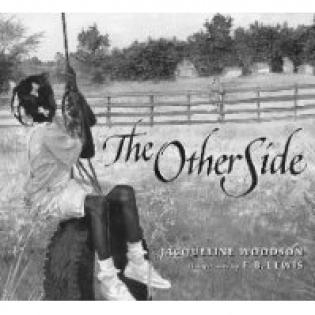The Other Side Literature Guide
Jacqueline Woodson has created a beautiful story about the confusion of children over racial tension. One of the most touching things about this book is that it is the children who give us hope for the future. With the help of this book, you can empower children to feel that they can make the world a better place.
Before Reading
ASK: What is the purpose of a fence?
SHOW: Look at the picture on the cover and read the title of the book. Talk about what is on each side of the fence on the cover. Talk about what those girls might be thinking. Think of some reasons why those girls aren’t playing together.
CONNECT: Name some boundaries you are not allowed to cross—maybe it is a busy street or even the door of your sister’s room. What other boundaries do you know about that are okay to cross. Talk about what a boundary is and some reasons boundaries cannot be crossed (privacy, safety, avoid disputes).
During Reading
ASK: Why do you think the white girl seems so sad? How do you think the black girl feels about that girl?
SHOW: Look at the picture of the girls seeing each other in town. Notice how the girls are dressed so much alike. The mothers are dressed alike, too. Do you think it is confusing to the girls why they should be kept apart? They are neighbors, the same age, and have the same interests. Doesn’t it seem that, of course, they should be friends? Why do you think the girls are looking at each other but the mothers aren’t?
CONNECT: Why do you think the adults don’t try to change “the way things have always been?” Is it up to children to make changes in the world because adults won’t? What changes would you like to make to today’s world?
After Reading
ASK: Why do you think Clover’s mother didn’t tell her to get down from the fence?
SHOW: Look at the pictures on the last two pages of all the girls on the fence. What do you think is going on in these pictures?
CONNECT: Have you ever felt like something was wrong and you knew something had to be done to fix it? What did you do about it?
Activities
- Annie and Clover were taking steps toward making their world a better place. Sometimes children are the best people to make changes because adults are used to doing things in a certain way. Think of something you (and your friends) can do to make the world a better place. Think of an issue, such as hunger, pollution, a sick neighbor, or recycling. Make a plan for a small thing you can do to improve the problem. Do it.
- Annie and Clover made friends slowly. They watched each other and moved carefully together, step-by-step. Talk about how you make friends. What do you say and do? Do you make friends in the same way in the neighborhood as you do at school? Where else have you made a friend? Do your friends look like you and act like you (same gender, same skin color, same religion, same personality, etc.)? Draw pictures of yourself playing with your friends.
- The illustrator of this book, E. B. Lewis, used watercolor paints for the pictures. Get some watercolors and paint a picture of what a caring community looks like.
- Think of someone at school or the playground who often plays alone (or a neighbor who lives alone). Next time you are there, ask that person to play. Make a plan now for what you will say and do to include him or her in your play activity.
